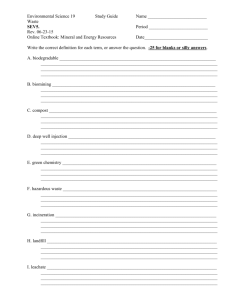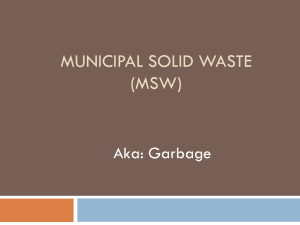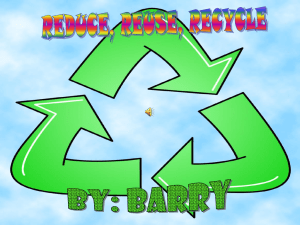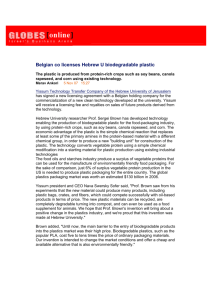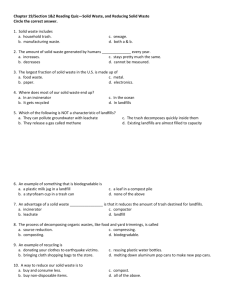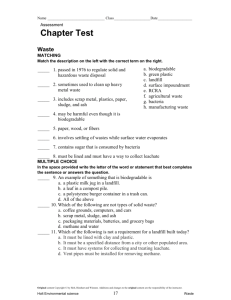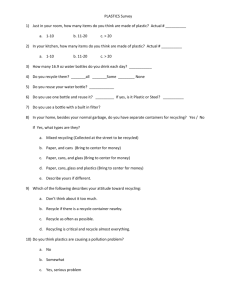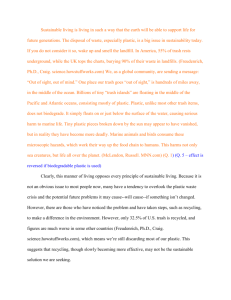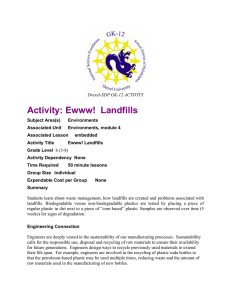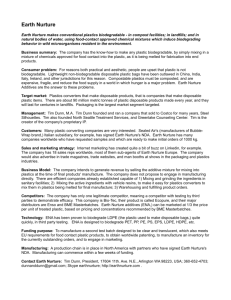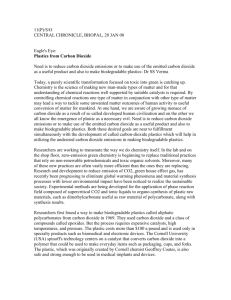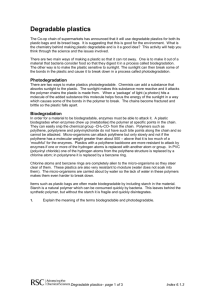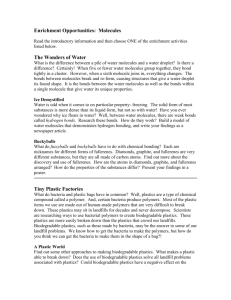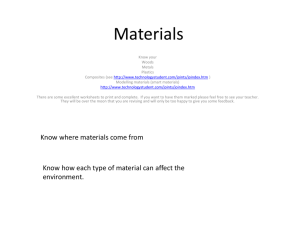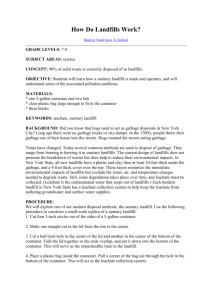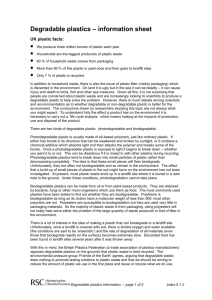Chapter 19: Waste Guided Notes section 1 Generation of Waste
advertisement
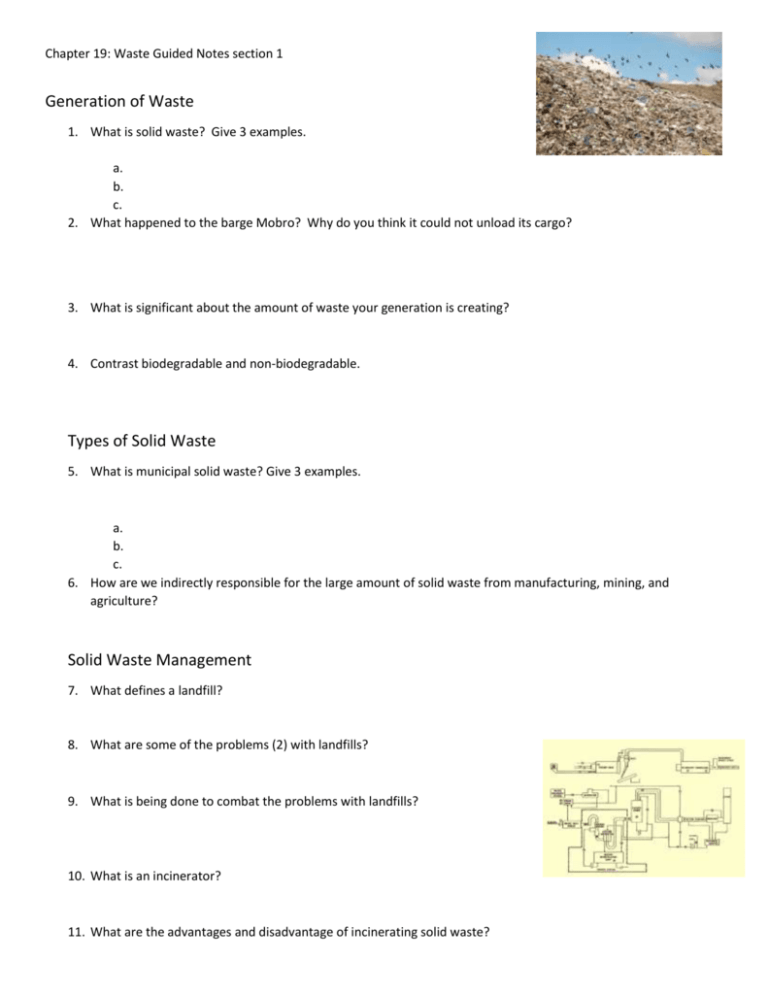
Chapter 19: Waste Guided Notes section 1 Generation of Waste 1. What is solid waste? Give 3 examples. a. b. c. 2. What happened to the barge Mobro? Why do you think it could not unload its cargo? 3. What is significant about the amount of waste your generation is creating? 4. Contrast biodegradable and non-biodegradable. Types of Solid Waste 5. What is municipal solid waste? Give 3 examples. a. b. c. 6. How are we indirectly responsible for the large amount of solid waste from manufacturing, mining, and agriculture? Solid Waste Management 7. What defines a landfill? 8. What are some of the problems (2) with landfills? 9. What is being done to combat the problems with landfills? 10. What is an incinerator? 11. What are the advantages and disadvantage of incinerating solid waste? Chapter 19: Waste Guided Notes section 1 Answers chapt 19 section 1 1. Any material that is discarded (thrown away) that is solid; mail, coffee grounds, and cars 2. The barge Mobro sailed up and down the east coast looking for a place to dump its garbage, but when found no one to take the garbage it was burned in the New York. Garbage presents many health and environmental hazards and no one want to take on more hazards. 3. The amount of waste we create is increasing while the amount of land to live on, dump trash, and grow crops is decreasing. 4. Biodegradable can be broken down by nature, while, non-biodegradable cannot. 5. Municipal solid waste is the waste produced by households or businesses; plastics, metal, and rubber 6. Consumers indirectly create waste by purchasing products that have been manufactured instead of homemade. 7. A landfill is a permanent waste-disposal facility where wastes are put in the ground and covered each day. 8. One problem is leachate which is the liquid that passes through the compacted waste and seeps down into the water table bringing chemicals with it. Another problem is the methane gas production that can get into homes and can be ignited by a spark. 9. Landfills must be lined with plastic and clay to prevent leachate, and pipes to vent the methane gas. 10. An incinerator is when solid waste is burned at a very high temperature so that the amount of waste is reduced. 11. Advantages of incinerators includes the reduction of solid waste by 75 %. Disadvantages include that the waste does not completely disappear, and some chemicals like cleaners and battery acid produce toxic air pollution when burned. chapter 19 Section 2 Guided Notes The method to reducing solid waste is known as source reduction. This is any change in design, manufacture, purchase, or use of materials or products to reduce their amount or toxicity before they become municipal waste. Many ideas for reducing waste are common sense (give 3 examples) 1. buying less and using products that last longer 2.Recycle materials we use 3. change the materials we commonly use like paper cups instead of plastic As a consumer you can influence manufacturers to produce less waste though:_buying products that have less packaging, last longer, and are reusable._This will encourage the manufactors to_produce more of those products.________. Manufactures could also reduce waste and conserve resources by redesigning products to use less materials Recycling is the process of:__reusing material or recovering valuable materials form waste or scrap_____ Making products from recycled materials usually saves __energy__ _water__ __and other resources__ A series of steps is needed for recycling to work: First: discarded materials must be collected and sorted Chapter 19: Waste Guided Notes section 1 Next: each type of material must be taken to a facility where it can be cleaned and made ready to be used again Then: the materials are used to manufacture new products Finally: the new products are sold to consumers. Yard waste usually makes up more than __15___ percent of a community's solid waste. Compost is__a dark brown crumbly material made from decomposing plant and animal matter that is spread on gardens and fields____ The more _oxygen_ and __moisture___ there are in a compost pile, the more rapidly it will be broken down by__microorganisms__. 6 benefits of composting are: 1 keeps organic waste out of landfills 2. Provides nutrients to the soil 3 increases benficial soil organisms, such as worms and centipedes 4 suppresses some pant diseases 5 reduces the need for fertilizers and pesticides 6 protects soil from erosion Simply changing the materials we use could eliminate much of the solid waste we produce. For examples single serve drink containers are hard to recycle because: there is no easy way to separate the materials it is made from to recycle them. the solution to this is to: make the containers of only one recyclable material. Recycling other common household products into new usable products could also help reduce solid waste. For examples newspaper can be recycled to make __cardboard__,__egg cartons___, and_building materials__ Two other examples of household products being remade into usable products are 1. magazines and catalogs can be made into building materials 2. aluminum cans can be made into new cans, lawn chairs, siding, etc. Most plastics are not biodegradable, but there are a few types that are. They are as followed: photodegradable plastics: which work by leaving them in the sun so that the material becomes weak and brittle and will break down into pieces. green plastic: which is made from_blended sugars in plants with special chemicals___ They also require less _fossil_ _fuels___ to be produced. The problem with biodegradable plastics is: they are only reduced to smaller pieces and do not completely go away. The plastic is less harmful to animals however, __the small pieces of plastic do not disappear completely_______________. These means the biodegradable plastics will___remain in landfill for many years________
